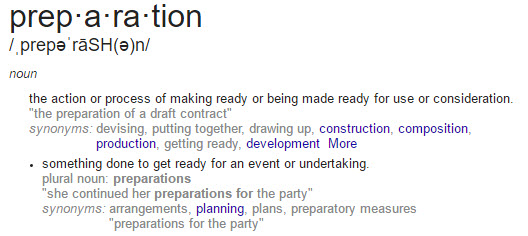I have spoken to people that believe that planning and goal making are not really for them. They believe that if they plan, they will be constricted, and if they make goals, they will just set themselves up for failure. I guess that is one way to look at it, and I can understand the latter part of that. I admit that I don’t know everyone in the world (not even close), but I have never heard a successful person say something like that. There are people that seem to have a lot of luck in life, but for the rest of us, we need to prepare ourselves for success, and we need to plan for it. Graveyards are riddled with good intentions, lost hopes, failed dreams, and plenty of regrets.

Preparation, Prepare, Preparing
Preparation is a part of life. We grow-up with it in everything we do. Washing our hands before dinner, getting dressed to go somewhere, brushing our teeth before bed, and a million other mundane tasks – ingrain in us that “preparation” is an important part of life. Somewhere in life, many people get tired of preparing, perhaps they failed at achieving some goals, perhaps they got sick of chasing the dream. When it comes to personal or organizational success, we always have to be preparing. How do we prepare:
- Read books that improve our knowledge and skills
- Hire a coach to improve accountability and learn new methods
- Be a part of a mastermind group to improve accountability, collaboration, and meet new people
- Attend social events and conferences to learn and increase our network
- etc… etc…
Everyone is preparing for something, are you preparing for success, or preparing for failure? If you don’t prepare, its unlikely you’ll make it to where ever it is you want to go, in fact you may not ever start.
Plan, Planning
I have been talking about planning all week in the posts I’ve shared. We can prepare all the time, by reading books, getting a coach, but hopefully all that is a means to an end, an end that brings you success, happiness, security, or what ever it is you are after. Sitting down and making “a decision about what one is going to do,” and then designing a road-map to get to that destination, will bring clarity.
- Clarity about what is more important
- Clarity about who is more important
- Clarity about your purpose
- etc… etc…
If you don’t plan, you don’t know where you’re going or how you are going to get there. Whether it is organizational objectives and plans, or personal objectives and plans, they both bring greater purpose and action. Don’t be the kind of person that reads lots of books and is always preparing for something, but never sits down and makes a plan to obtain that something, and use those skills. Graveyards are riddled with smart, brilliant people, that didn’t plan or execute.
What are you going to do to start preparing and planning? Share your thoughts in the comments section.


 What I am about to lay out is no secret. In fact there are probably thousands of sites that talk about this, but I am hoping that I can simplify it and and encourage everyone to understand the importance of planning, and how to do it. I wanted to write about this because it boggles my mind how many business owners/CEOs/Presidents I have met, that do not know how to write a Business Plan. Plus how many Director of Sales/VP of Sales people I have met that do not know how to write a Sales Plan, and how many Director of Marketing/VP of Marketing people that I have met that do not know how to write a Marketing Plan. Not sure how any professional of that level could get hired without the leadership ability to plan, but it seems to happen quite often.
What I am about to lay out is no secret. In fact there are probably thousands of sites that talk about this, but I am hoping that I can simplify it and and encourage everyone to understand the importance of planning, and how to do it. I wanted to write about this because it boggles my mind how many business owners/CEOs/Presidents I have met, that do not know how to write a Business Plan. Plus how many Director of Sales/VP of Sales people I have met that do not know how to write a Sales Plan, and how many Director of Marketing/VP of Marketing people that I have met that do not know how to write a Marketing Plan. Not sure how any professional of that level could get hired without the leadership ability to plan, but it seems to happen quite often. I have seen a lot of failed strategies with companies, as I am sure you have as well. These strategies come in many shapes and sizes. Sometimes they are an idea on the back of a napkin. Sometimes they are a copy or slight modification of a competitor’s strategy, sometimes they are a fancy PowerPoint full of charts with hockey stick curves. The same is true for the personal strategies to get us where we want to go in life.
I have seen a lot of failed strategies with companies, as I am sure you have as well. These strategies come in many shapes and sizes. Sometimes they are an idea on the back of a napkin. Sometimes they are a copy or slight modification of a competitor’s strategy, sometimes they are a fancy PowerPoint full of charts with hockey stick curves. The same is true for the personal strategies to get us where we want to go in life.

 “Everything is theoretically impossible, until it is done.” An American science-fiction author, Robert A. Heinlein, is responsible for capturing the essence of execution in these eight simple words.
“Everything is theoretically impossible, until it is done.” An American science-fiction author, Robert A. Heinlein, is responsible for capturing the essence of execution in these eight simple words. I know I am an odd one, but I actually like vanilla ice cream, in fact it is my favorite flavor. Yet, even vanilla ice cream has a lot of varieties, and there are a few brands that are greatly superior than the others. Whether your business is about ice cream, candy, technology, widgets, or some other gadget …differentiation is one of the things that separates the good from great!
I know I am an odd one, but I actually like vanilla ice cream, in fact it is my favorite flavor. Yet, even vanilla ice cream has a lot of varieties, and there are a few brands that are greatly superior than the others. Whether your business is about ice cream, candy, technology, widgets, or some other gadget …differentiation is one of the things that separates the good from great!
 The world is full of recipes for success, but many times we forget that success comes from within ourselves with work that we do. I would even claim that success is mainly about attitude. When you have the right attitude, you focus on the right things, obstacles are there to overcome, you feel better and work more efficiently. I am sure you know what happens if you have a bad attitude: nothing seems to work at that time. Here are some questions for you to ask to become more successful through your own attitude towards other people and life. Even though you may not have answers to every one of them, thinking about these matters will already take you towards your personal success.
The world is full of recipes for success, but many times we forget that success comes from within ourselves with work that we do. I would even claim that success is mainly about attitude. When you have the right attitude, you focus on the right things, obstacles are there to overcome, you feel better and work more efficiently. I am sure you know what happens if you have a bad attitude: nothing seems to work at that time. Here are some questions for you to ask to become more successful through your own attitude towards other people and life. Even though you may not have answers to every one of them, thinking about these matters will already take you towards your personal success. Leadership is not just a title; and a leadership title, does not necessarily make someone a leader. There are many unsung people in every organisation who exercise the attributes of a leader everyday without the recognition of title. These are the ones who take ownership for their own area of the organisation. They do the best they can to fulfill the cause or vision. They are often un-thanked, forgotten, and overlooked.
Leadership is not just a title; and a leadership title, does not necessarily make someone a leader. There are many unsung people in every organisation who exercise the attributes of a leader everyday without the recognition of title. These are the ones who take ownership for their own area of the organisation. They do the best they can to fulfill the cause or vision. They are often un-thanked, forgotten, and overlooked.